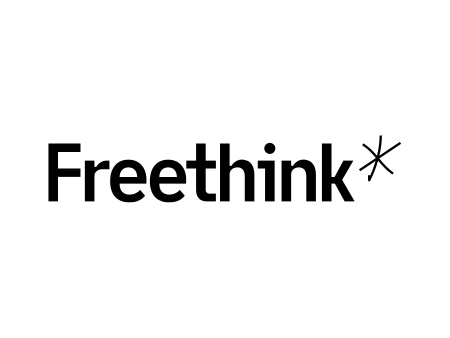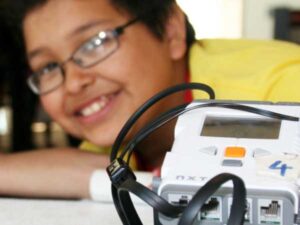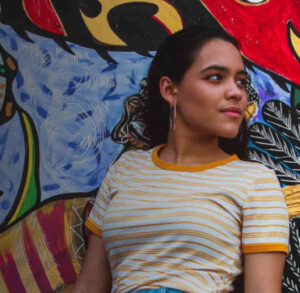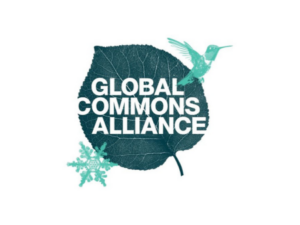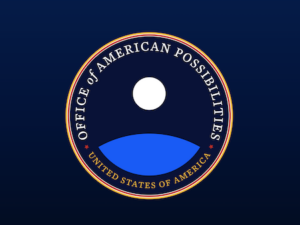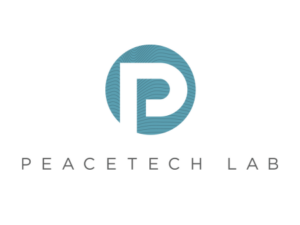Freethink is a digital publisher focused on changing the world and moving the world forward through storytelling. The organization has two brands, Freethink Media and Big Think Media.
Blair Milam of Freethink spoke with Alec Saelens on April 25, 2024. Click here to read the full conversation with insights highlighted.
Alec Saelens: Can you introduce yourself and introduce the work of your organization? What is the issue that you’re grappling with, and what is the response that you’re bringing through your work?
Blair Milam: My name’s Blair Milam. I am the vice president of brand partnerships and strategy at Freethink Media. Freethink Media is a digital publisher focused on changing the world and moving the world forward through storytelling. We specifically look at the intersection of people thinking differently and making a difference in our world today, and we focus on telling those stories through a confident and clear lens. We have two brands, Freethink Media and Big Think Media, and we think of them as synergetic sisters in the sense that Big Think is bringing together all of the academics, the ideas people, and the biggest thinkers of our time, and recording and documenting what they have to share with the world to advance it forward. Think about it as the non-fiction side of the bookstore. Freethink Media is all about the humans in the arena whose endeavors are valiant, worthwhile, and extraordinary, regardless of success or failure. Those stories deserve to be told in the midst of the storm cloud of negativity, fearmongering, and status quo that dominates our media landscape today.
Alec Saelens: Thank you for that background. Who would you consider the main beneficiaries of your work, or the stakeholders of the world that you operate in?
Blair Milam: I think it’s both the human beings whom we are telling the story about and the human beings who are connecting to those stories. The goal is to create some type of inspiration, intimacy, or magical moment where true human connection comes about through storytelling. These are stories about how folks can change their lives, take agency in their lives, or provide themselves to be of service to a solution that moves our world forward collectively.
Alec Saelens: Could you give me an example of a piece of your work, or a couple of pieces of work, that illustrate what you’ve just shared there?
Blair Milam: There are so many. I think one of the most interesting pieces of work that we’re doing right now is with a group called Perception Box. It is a large-scale, multi-episodic series of three different series. One features scientists who are talking about the neurobiology of perception, and how our brains think. Another is about stories that are being untangled. Imagine pulling a thread through your life that represents figuring out the ultimate existential question of who you are, and then following different narratives around how folks that are household names, like Jim Lee, or Jack Osbourne, or Steve-O, have figured those things out for themselves. Then there’s one about genuine human inquiry. It’s called Thinking Inside Your Perception Box, and it explores people asking themselves questions like, “Who are you still trying to please?” Or, “Who are you trying to influence?” Or, “What are you trying to influence in the world? What is your biggest regret?”
That work comes to top of mind because when you’re thinking about expanding humans, and expanding a connection, especially right now within humanity, this is one of the most important pieces of work that you can share with folks, in terms of how they view themselves within the world, and how they have opportunities to expand and connect with others through their worldview, self-exploration, and inquiry. That’s one example, at a very meta level, of work that we’ve done.
We also work a lot in tech and science and think of ourselves fondly as nerds at Freethink. Coinbase has done a number of stories with us around clean energy, as well as some about non-fungible tokens [NFTs], specifically with artists, to understand how to expand using that modality to move their artwork forward in the world.
There is also a really interesting story about how a fisherman in Indonesia is tracking how his clean, certified fish are moving through the marketplace, and where they’re being sold through Bitcoin transactions.
Each one of those examples exemplifies, in its own right, how an individual can use a piece of technology to move their livelihood forward, to move their work forward, to move their perception forward, and educate others on how they might be inspired to do something similar or have access to tools and understanding so they can do something similar.
Alec Saelens: Can you tell me more about what makes your approach to films distinctive? Are there particular types of stories that you seek to tell? What is the process of devising these documentary pieces? What is the distinctive lens you bring?
Blair Milam: At the heart of every story we tell is a human intimacy moment. In traditional journalism, it’s more about facts, figures, numbers, and in some of your more historical-based storytelling, it’s all about the hero’s journey, and moving through that narrative arc. Both of those approaches absolutely have a place, but I think where Freethink shines is bringing viewers emotional movement that they can witness and experience in real-time. We like to say Freethink runs on tears, some of them joyful and some of them sad. We pull back all the layers, and all the situational aspects of the story itself, and get deep into the moment during which somebody becomes vulnerable and reveals an intimate impact in their life. It’s through that moment that you gain connection.
Alec Saelens: How do you get to extricating that, or to inducing someone to be that vulnerable? Do you have a method, or a specific practice that elucidates those kinds of behaviors in people, or that helps build trust?
Blair Milam: When I first started at Freethink five years ago, our founder said to me: “My co-director says I have to get somebody to fall in love with me, and I have five minutes to do it. What are you going to do in order to make that happen?” Yes it starts, first and foremost, with the facts and figures, with being well-informed, well-read, and knowledgeable about whatever topic or solution you’re going in to understand. But I think it’s more than that. It’s also about personal curiosity. Asking the question out of a genuine, authentic curiosity to understand this human being in front of you, as opposed to trying to craft a narrative, or move a narrative forward, and to be open to the mess that might unfold when you do that.
We like to have things in perfect nice boxes, and we like to control them. We like to move them where we want them to go, and the reality is that life just doesn’t work that way. Our idea is doing extensive pre-interview research for several weeks before we go into a conversation with a subject, and then going in with our guard down. We need to be open to intimately and vulnerably connecting with a person to create symbiosis.
Alec Saelens: How do you measure the success of your work at Freethink? What kind of evidence do you gather? What do you look at when assessing whether you’re making progress, or whether the needle is moving in the right direction for you?
Blair Milam: This is one of my favorite things to talk about because this was a specific gap that we saw in the traditional media agency model. Most of the time, content creation and content distribution were a bit like the separation of church and state. There wasn’t a lot of continuity between them. Someone would make something, and then ask: “What do we do with this?” It was sad and discouraging for a lot of folks to put all this heart, time, and effort into a piece of well-made content, and then see that content fail to get the meaningful distribution and attention it deserved.
From the jump, we decided that this issue was important to us, and that we were going to look at completed views of our videos, specifically on the YouTube and Facebook channels, and to use that metric as opposed to the millions of top-line views and viral views, which were all the rage in the media world at the time. At the end of the day, it’s a quick click, it’s a nice scroll, but it’s not actually consumption of a piece of content.
Most of our pieces nowadays are between 4 and 8 minutes in length, and we consider a completed view to be 75% or more of a video. We provide performance reports on our videos so we can have a clear understanding of who’s viewing the video, identify their demographics, psychographics, and geographics, and see which platforms they’re visiting to view the content. Then, we can serve that video through strategic paid media campaigns to more people like those audiences that we already know have an interest in it, and expand viewership even further.
Alec Saelens: Do you use any strategies to engage with communities and the public, and to distribute content so it gets more visibility? How do you make sure that content reaches the people who are affected by the issues being presented? How do you think about the impact of your work in that context?
Blair Milam: We think about this as a value beyond views, and that’s what we aggregate it towards. We usually have dedicated engagement editors for each one of the verticals or topic areas that we work off of, so every piece of content has somebody dedicated to managing the YouTube comments, and pinning additional information or articles where questions are asked. Viewers are not having a robot interaction experience, but are having a human experience. Like we’ve been touting all along, there are people guiding you along the journey, asking thoughtful questions and placing content in unusual places. Reddit is a place where we’ve generally found a lot of fruitful discussion and commentary, as well as Facebook. That’s been the traditional way that we reach people who are not just watching longer-form content, but really engaging with longer-form content.
We measure things like sentiment analysis, comment engagements, likes, comments, and shares. We also pay attention to click through rate [CTR], to identify what people are clicking through, and whether they are staying with the content. Are they not only making it in, but are they staying and watching a certain amount? Are they dropping off at a certain point? We pay attention to all those things to make sure we’re doing our best to keep people engaged.
In terms of the locality of what we’re doing, yes, we absolutely do targeted campaigns, sometimes from a paid standpoint and sometimes not, to specific locations where the issue is, and where we’re filming and approaching from. We also do a lot of cross-posting partnerships and provide video back to organizations we film, in ways that don’t only speak to the Freethink audience, but also speak to their audience and those needs. A lot of the organizations that we work with need volunteers, or they need donors, or they need a political figure to pay attention to them. Crafting narratives in a way that will meet those needs, as well, is also a part of what we do.
Alec Saelens: Do you think about advancing systems-level change in this particular field, in terms of documentary content or production? Is there an attempt to get the field to shift its practices and behaviors and approach storytelling in a different way? If so, how do you contribute to making that happen?
Blair Milam: I think almost anyone you ask would agree that mainstream media today is in a life crisis, and there is a real engine and yearning for an organization, or multiple organizations, to be thoughtful, confident, curious, and open in their approach to reporting. Those are the four values that we hold tight and dear at Freethink: thoughtful, open, curious, and confident in everything that we do, report on, make, and interact with.
I think it’s going to take a whole army of people leading by example, and that working from the bottom up is one of the best ways to change the actual system, so that we’re able to access a new way of storytelling, then a new standard of storytelling, and then hold people accountable to it. I also think it’s important to be aware of whether or not people are paying attention to the content, and the way to do that is by starting new metric systems, like measuring completed views and doing engagement analysis, and showing that to folks when they ask. I think the other question or entry point here that we could talk about for the media at large is the excess number of different platforms, and the many different ways that those platforms are controlled. We’ve been digging our feet in and going hard for the last eight years to build our own media company so we can do things the way that we want to do them. That speaks for itself because I know a lot of people have tried to do it and failed.
Alec Saelens: What’s one teachable lesson that makes your work successful? What’s the secret ingredient, or the insight that speaks to your success, your viability, and your sustainability, something you would want to share with people who are trying to emulate your work, or enter this space and participate in systems-level change?
Blair Milam: I think it can be distilled down to one thing, and I’ve been talking a lot about it lately, and that is witnessing someone else’s intimate human moment. That is a universal human trait that everyone can understand. We saw Skoll do it at the World Forum, with the card video that Gabriel so expertly crafted, that led people to connect over a card game. I think it’s things that don’t necessarily make us unique that are the catalysts to expand this movement: intimacy and vulnerability. It’s about the way you approach and talk to everyone in your sphere, starting from trying to initiate a story, all the way through completion. That’s really lacking in the world today.
Alec Saelens: That’s a wonderful way to end this conversation and a great takeaway. Thank you for your time.
Click here to read the full conversation with insights highlighted.
Alec Saelens is a former journalist who supports SJN and its partners track solutions journalism’s impact on society and the industry. In his former role, he researched and consulted on the connection between solutions journalism and revenue. He is co-founder of The Bristol Cable, the UK’s pioneering local media cooperative. Before SJN, he was a researcher and coach for the Membership Puzzle Project and an analyst for NewsGuard.
* This interview has been edited and condensed.

